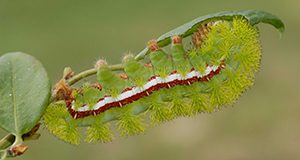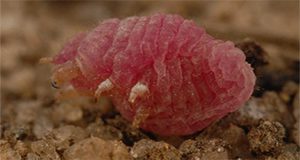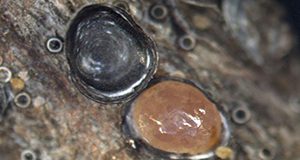This series of Key Plant, Key Pests publications are designed for Florida gardeners, horticulturalists, and landscape professionals to help identify common pests associated with regional flora. This new 6-page publication of the UF/IFAS Environmental Horticulture Department helps identify the most common pests found on trees in the sycamore group, Platanus spp., and it provides information and general management recommendations for sycamore lace bug, bacterial leaf scorch, powdery mildew, anthracnose, and canker stain. Written by Matthew Borden, Kelly Laplante, Juanita Popenoe, Adam Dale, Caroline R. Warwick, and Brian Pearson.
https://edis.ifas.ufl.edu/ep601
Tag: Adam Dale
Galling Damage to Woody Ornamentals: Diagnosis and Potential Causes
Galling or witch's broom damage on the newly expanding buds and leaves of woody ornamental plants has become increasingly common. Diagnosing this damage can be difficult because the most common causes are obscure or occur well before damage symptoms appear. This 6-page fact sheet written by Adam Dale, Erin Harlow, Carrie Harmon, and Chris Marble and published by the UF/IFAS Entomology and Nematology Department is intended to help landscape managers, nursery growers, and pest control professionals diagnose characteristic galling damage, mitigate damage that occurs, and, when possible, prevent it from occurring.
https://edis.ifas.ufl.edu/in1310
Elongate Hemlock Scale, an Exotic Scale Insect Pest of Christmas Trees and Other Conifers
Elongate hemlock scale, Fiorinia externa Ferris (Hemiptera: Diaspididae), is an armored scale insect native to Japan and eastern Asia. This insect was first documented in the United States in 1908 in Queens, NY, and has since spread throughout most of the eastern United States. Though the primary hosts of the pest, hemlocks and firs, do not occur in Florida, there are concerns that elongate hemlock scale coming into the region on cut Christmas trees may disperse and establish on conifers that do occur in Florida. Of specific interest are two endangered species, Florida torreya (Torreya taxiflora) and Florida yew (Taxus floridana), which are native to a small region in northwestern Florida. Also of concern are Florida forestry species, Florida Christmas tree species, and species used for ornamental plantings in Florida. What can Florida do to protect its native conifers and farmed trees from the elongate hemlock scale? Find out in this 5-page fact sheet written by Adam Dale, Travis Birdsell, and Jill Sidebottom and published by the UF/IFAS Entomology and Nematology Department.
http://edis.ifas.ufl.edu/in1253
Managing Insecticide and Miticide Resistance in Florida Landscapes
Resistance to insecticide or miticide is a worry for landscape managers. Around the world, chinch bugs, leafminers, and other insect and mite pests have become resistant to dozens of insecticides, but with diligent insecticide resistance management, we can still maintain long-term effective chemical control. With few new modes of action coming onto the market, landscape managers need to be good stewards of existing products. Ultimately, resistance management means reducing exposure of pests to any one pesticide. Fortunately, there are many ways to prevent resistance and still control pests of ornamental plants and lawns, and this 6-page fact sheet written by Nicole Benda and Adam Dale and published by the UF/IFAS Entomology and Nematology Department explains how.
http://edis.ifas.ufl.edu/in714
Stinging and Venomous Caterpillars of the Southeast
Wasp and bee stings are familiar to most people, but some might be surprised to learn that several caterpillars can also sting. Unlike wasps and bees with stingers, these caterpillars have barbed hairs that break off the caterpillar when it brushes against something. The hairs embed in skin and cause sudden or gradually building pain. The severity of a caterpillar sting varies based on the person and number of spines in the skin. Many stinging caterpillars also release a toxin on contact, which may cause health problems for some people. This 4-page fact sheet written by Rebecca Perry and Adam Dale and published by the UF/IFAS Department of Entomology and Nematology describes several stinging caterpillars commonly found throughout the southeastern United States.
https://edis.ifas.ufl.edu/in014
Florida-Friendly Landscaping Guidelines for Community Associations: Considerations for Selecting a Landscape Contractor and Writing an Effective Landscaping Contract
Florida-Friendly Landscaping protects Florida’s unique natural resources by conserving water, reducing waste and pollution, creating wildlife habitat, and preventing erosion. This 12-page document will help the reader with selecting and writing a landscape contract that follows Florida-Friendly Landscaping principles. Written by Adam Dale, Claire Lewis, Esen Momol, Don Rainey, John Bossart, C. J. Bain, Jen Marvin, Lynn Barber, Norman Leppla, Gary Knox, and Thomas T. Ankerson and published by the UF/IFAS Environmental Horticulture Department, June 2018.
http://edis.ifas.ufl.edu/ep347
Managing Whiteflies on Landscape Ornamentals
Whiteflies are a common pest of many ornamental plants throughout Florida and the world. There are more than 1,500 species worldwide and over 75 reported in Florida. Although infestation does not always require treatment, it is important to be able to identify and monitor for these pests for effective integrated pest management. This 8-page fact sheet written by Eileen A. Buss, Catharine Mannion, Lance Osborne, and Adam Dale and published by the Entomology and Nematology Department describes whitefly species, their identification and biology, the damage they cause, and best management practices to control them and still maintain healthy populations of natural enemies and other beneficial insects.
http://edis.ifas.ufl.edu/mg254
Managing Scale Insects and Mealybugs on Turfgrass
This 8-page fact sheet written by Adam Dale and published by the UF Department of Entomology and Nematology in February 2017 describes the types of scale insects and mealybugs that can become pests in turf, explains the damage they do, and lists management techniques to control them.
http://edis.ifas.ufl.edu/in1166
Managing Scale Insects on Ornamental Plants
Scale insects are a diverse group of piercing-sucking pests (Hemiptera) commonly found on ornamental plants in landscapes and nurseries. There are over 180 species of scale insects in Florida, but only a small percentage are important pests of ornamental plants. They damage plants and secrete a waxy covering that makes them difficult to control using most chemical control measures. This 7-page fact sheet written by Eileen A. Buss and Adam Dale and published by the Department of Entomology and Nematology differentiates between armored and soft-scale insect pests and lists common types of each, provides information about the biology of scale insects and how to identify them and the damage they cause, describes how to scout and monitor for scale insects, and lists several methods for prevention and control of scale insect invasions.
http://edis.ifas.ufl.edu/mg005








